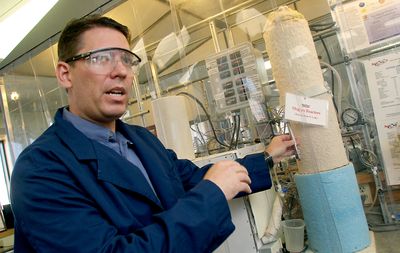Pond scum produces diesel
Chemist says process is cheap, portable and uses biowaste

MINNEAPOLIS – A Minnesota biofuels company that has attracted visits from financiers, scientists, customers and the federal government has produced a clean diesel fuel from algae harvested from a pond next door to its plant.
The development could prove big for the alternative-fuels business and the Midwest economy.
Clayton McNeff, a chemist and veteran industrialist, said his family-owned SarTec Corp. has perfected a 3-year-old “continuous flow” process and produces about 1,000 gallons of diesel weekly for $1.25 to $1.75 per gallon from a variety of feedstock, including restaurant and ethanol-plant waste oils, nonedible crops and plain old pond scum.
“We see this as revolutionary technology, and we’re not trying to keep it a secret,” said McNeff, 40, who recently published a peer-reviewed scientific paper.
“You can deploy this technology using small mobile units, so you don’t need to send feedstocks hundreds of miles,” McNeff said. “You just use local crop waste, or ethanol waste oil or algae. We will license it and make money. We also want this to do as much good in the world as possible.”
McNeff has raised about $7 million from family and friends to construct a “two-reactor” pilot plant in Isanti, Minn., which will open in June.
His “Ever Cat Fuels” expects to produce 4 million gallons of clean diesel annually from a variety of feedstocks.
“This technology has the potential to help with energy security and climate change,” Peter Agre, a Nobel Prize-winning chemist who directs the John Hopkins Bloomberg School of Public Health, said in a recent letter of support to federal officials. “These are two of the most important issues we face in terms of our country’s economic and environmental future.”
The U.S. consumes about 140 billion gallons of gasoline and 60 billion gallons of diesel per year, mostly distilled from imported oil, to fuel vehicles, trains and ships. Last year, in response to soaring fuel prices, national security and global warming concerns, then-President George W. Bush signed into law legislation that mandates increasing amounts of homegrown fuels from renewable sources.
National demand for biodiesel has grown from 25 million gallons in 2004 to 450 million gallons this year, according to the Agricultural Utilization Research Institute.
“There are some really good business opportunities that make use of waste oils such as technology that Clayton is developing,” said Doug Cameron, chief scientific adviser at investment bank Piper Jaffray & Co. “These plants will not get us entirely off petroleum, but they have the potential to contribute to our fuel supplies. There is a big opportunity with algae. It is unproven at this point. But the research and use of algae at waste treatment plants, which also cleans up the phosphorus and other pollutants, and the use of carbon dioxide at power plants is encouraging. There’s a double benefit. I’m cautiously optimistic.”